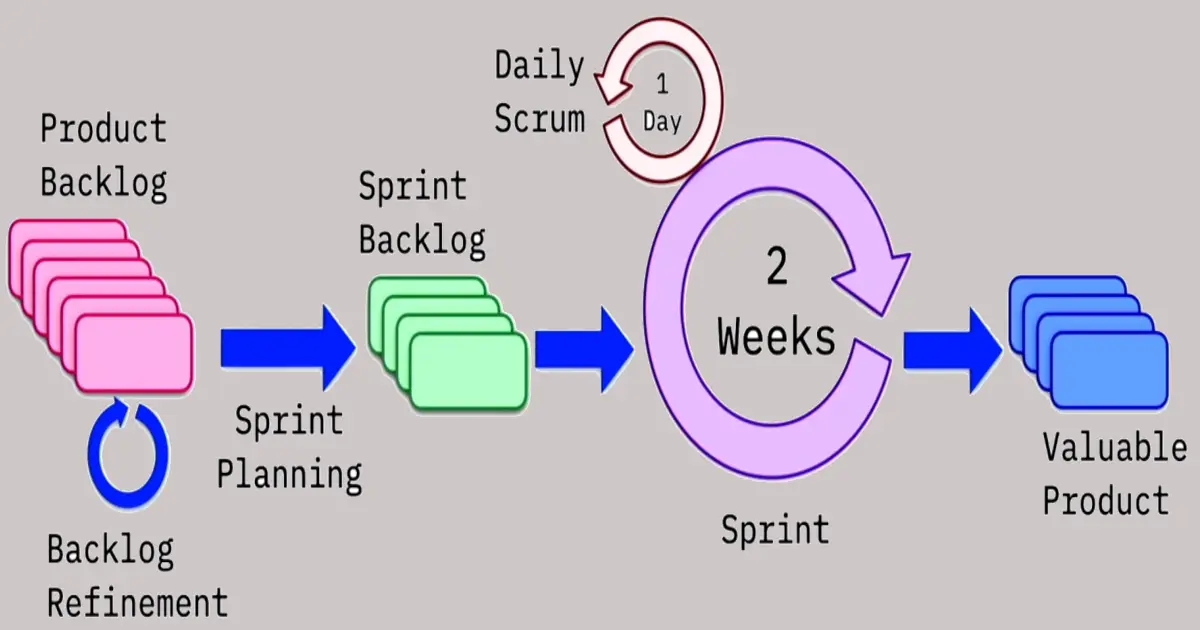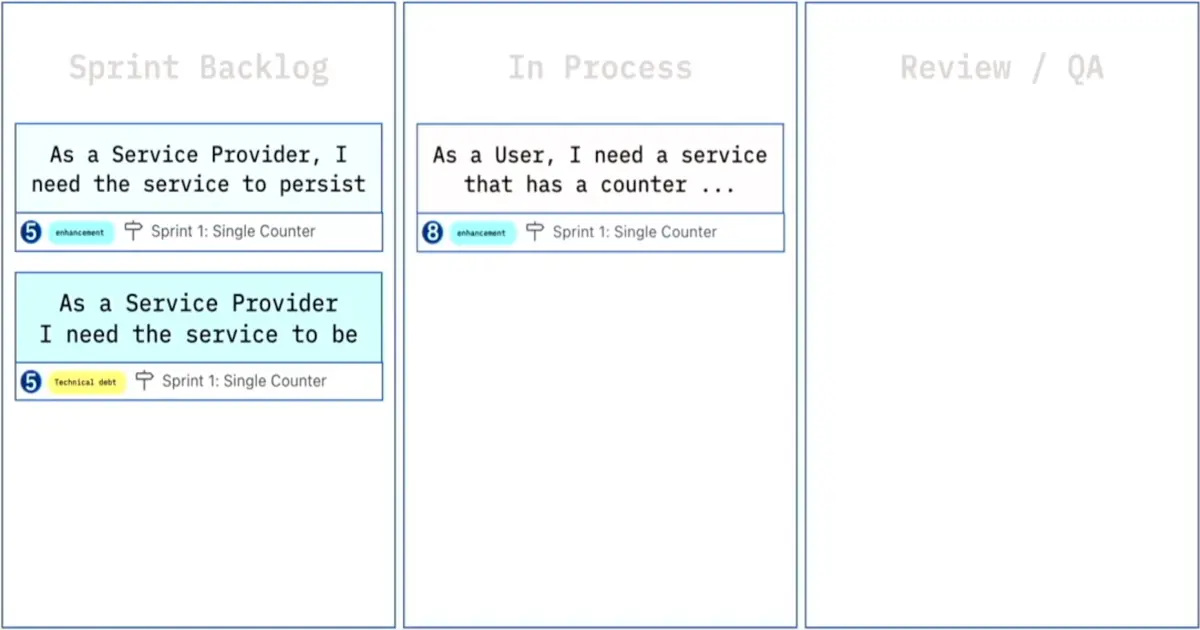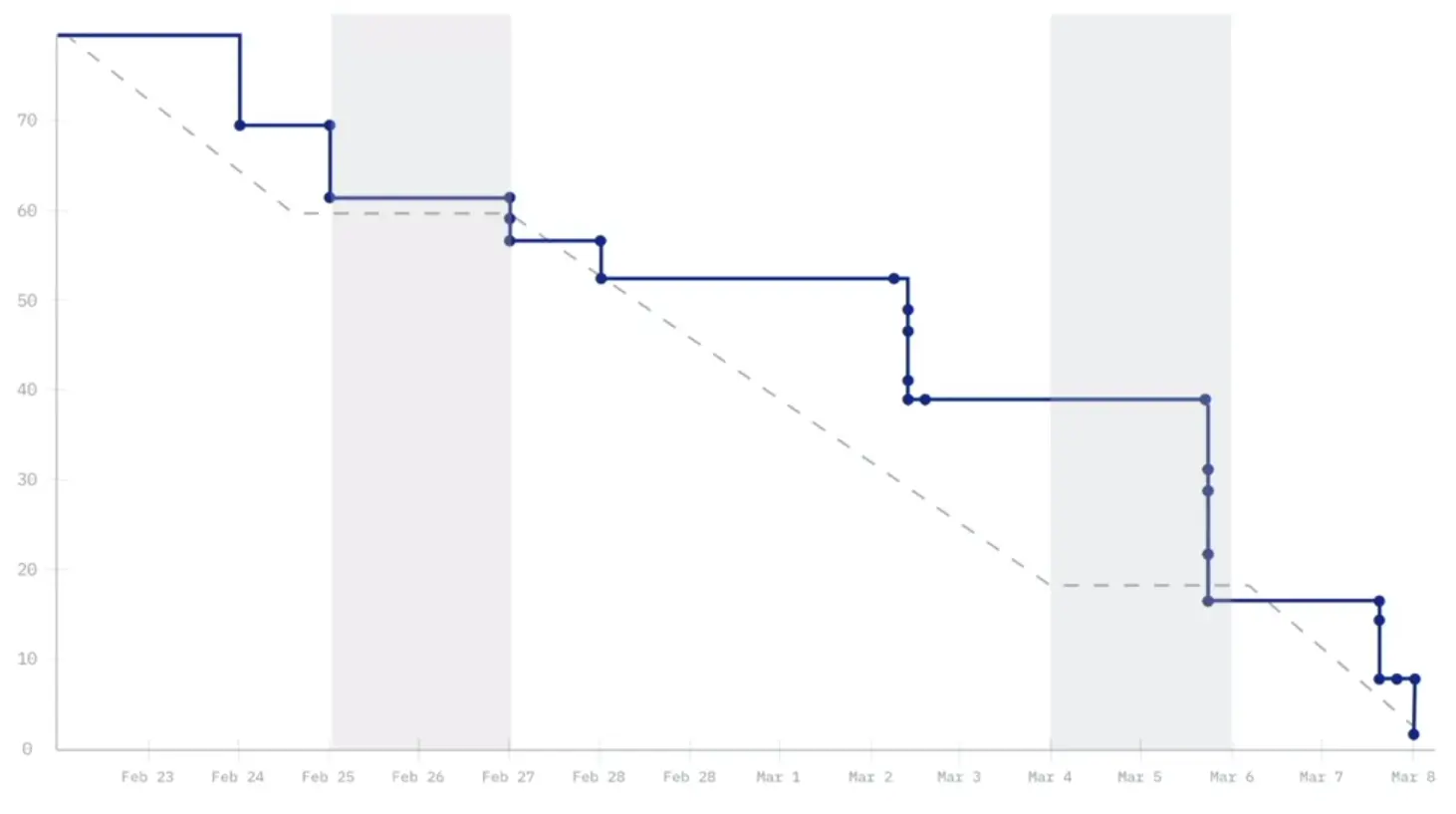Executing the Plan
Workflow for Daily Plan Execution
Steps in the Scrum Process:
The Sprint:
-
A sprint is one iteration through the design, code, test, deploy cycle
-
It is usually 2 weeks in duration
-
Every sprint should have a goal
Daily Execution:
-
Take the next highest priority item from the sprint backlog
-
Assign it to yourself
-
Move it in process
- No one should have more than one story assigned to them unless they are blocked
- When you are finished, move the story to Review/QA and open a PR
- When the PR is merged, move the story to the Done column
The Daily Stand-Up
-
Occurs every day at the same time and place
-
Sometimes called the “daily Scrum”
-
Each team member briefly reports on their work
-
Called a “stand-up” during the meeting to keep it short
-
Timeboxed to 15 mins
-
Not a project status meeting – all status should be tabled for later discussion
Daily stand-up meeting:
Who should attend?
-
Scrum master
-
Development team
-
Product owner (optional)
Daily stand-up question:
Each team member answers three questions:
- What did I accomplish the previous day?
- What will I work on today?
- What blockers or impediments are in my way?
Impediments and blockers:
-
Impediments identified by the team should be unblocked by the scrum master
-
Developers that are blocked should work on the next story
Tabled topics:
-
Topics raised during the daily stand-up should be held until the meeting has ended
-
Anyone interested in those topics can stay to discuss
Completing the Sprint
Using Burndown Charts
Milestones and burndowns:
-
Milestones can be created for anything in your project
- sprint, beta drop, demo, release…
-
Burndown charts can be used to measure your progress against a milestone
Burndown chart:
-
The measurement of story points completed vs. story points remaining for a sprint
-
Over time the story points remaining should go down, hence the name: burndown
Burndown chart examples:
The Sprint Review
-
Live demonstration of implemented stories
-
Product owner determines if stories are done based on acceptance criteria
-
Done stories are closed
Sprint Review meeting:
Who should attend?
-
Product owner
-
Scrum master
-
Development team
-
Stakeholders
-
Customers (Optional)
Sprint review:
-
Feedback gets converted into new product backlog stories
-
This is where iterative development allows the creation of products that couldn’t have been specified up-front in a plan-driven approach
Rejected Stories:
-
What about stories that are not considered done?
-
Add a label to indicate this and close them
-
Write a new story with new acceptance criteria
-
This will keep the velocity more accurate
The Sprint Retrospective
-
A meeting to reflect on the sprint
-
Measures the health of the process
-
The development team must feel comfortable to speak freely
Who attend the meeting:
-
Scrum master
-
Development team
A time for reflection:
Three questions are answered:
- What went well? (keep doing)
- What didn’t go well? (stop doing)
- What should we change for the next sprint?
The goal is improvement:
-
This is critical for maintaining a healthy team
-
The scrum master must ensure that changes are made as a result of the feedback
-
The goal is to improve for the next sprint
Measuring Success
Using Measurements Effectively
Measurements and metrics:
-
You can’t improve what you can’t measure
-
High performing teams use metrics to continually improve
-
They take baselines and set goals and measure against them
-
Beware of vanity metrics
-
Look for the actionable metrics
Baselines and Goals:
Baseline:
-
It currently requires 5 size team members, 10 hours to deploy a new release of your product
-
This costs you $X for every release
Goals:
-
Reduce deployment time from 10 hours to 2 hours
-
Increase percentage of defects detected in testing from 25% to 50%
Top 4 actionable metrics:
- Mean Lead Time
- How long does it take from the idea to production?
- Release Frequency
- How often can you deliver changes?
- Change Failure Rate
- How typically do changes fail?
- Meantime to Recovery (MTTR)
How quickly can you recover from failure?
Example metrics:
- Reduce time-to-market for new features
- Increase overall availability of the product
- Reduce the time it takes to deploy a software release
- Increase the percentage of defects detected in testing before production release
- Provide performance and user feedback to the team in a more timely manner
Getting Ready for the Next Sprint
End of sprint activities:
-
Move stories from done to closed
-
Close the current milestone
-
Create a new sprint milestone
-
Adjust unfinished work
Handling untouched stories:
-
Stories not worked on can be moved to the top of the product backlog
-
Resist the urge to move them to the next sprint
-
Remember to unassign them from the sprint milestone
Handling unfinished stories:
-
Don’t move unfinished stories into the next sprint!
-
Give the developers credit for the work they did
-
This will keep your velocity more accurate
-
Adjust the description and story points of the unfinished story, label it unfinished, and move it to done
-
Write a new story for the remaining work
-
Assign remaining story points and move it to the next sprint
Ready for the next sprint:
-
All stories assigned to the current sprint are closed
-
All unfinished stories are reassigned
-
The sprint milestone is closed
-
A new sprint milestone is created
Agile Anti-Patterns and Health Check
Agile Anti-Patterns:
-
No real product owner/Multiple product owners
-
Teams are too large
-
Teams are not dedicated
-
Teams are too geographically distributed
-
Teams are siloed
-
Teams are not self-managing
YOU WILL FAIL!
…and you should not wonder why.
Scrum health check:
- The accountabilities of product owner, development team(s) and Scrum master are identified and enacted
- Work is organized in consecutive sprints of 2–4 weeks or fewer
- There is a sprint backlog with a visualization of remaining work for the sprint
- At sprint planning a forecast, a sprint backlog, and a sprint goal are created
- The result of the daily Scrum is work being re-planned for the next day
- No later than by the end of the sprint, a Done increment is created
- Stakeholders offer feedback as a result of inspecting the increment at the sprint review
- Product backlog is updated as a result of the sprint review
- Product owner, development team(s) and Scrum master align on the work process for their next sprint at the sprint retrospective


